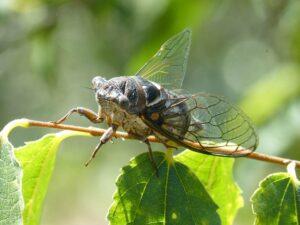Let’s protect our domestic plantations together against grapevine golden yellow disease
Grapevine golden yellow disease, spread by the American grapevine cicada, is currently the greatest threat to Hungarian viticulture, and the cooperation of all stakeholders is essential for effective control. The National Food Chain Safety Office (Nébih) draws the attention of grape growers to important information related to the topic and the necessary actions.

(Photo: Pixabay)
Almost all European grape varieties are susceptible to the grapevine golden yellow phytoplasma disease (Grapevine flavescence dorée, FD), spread by the American grapevine cicada. Merlot is less susceptible, but Chardonnay, Zweigelt, Kékfrankos and Pinot noir, as well as Szürkebarát, Cabernet sauvignon, Cabernet franc and Rizling are particularly susceptible to the most destructive phytoplasma disease of grapes.
Grapevine golden yellow phytoplasma often infects American rootstock varieties asymptomatically
The pathogen can also occur on other plants, such as forest willow, alder, linden, willow and hazelnut, but it causes economic damage only in grapes. The American grapevine cicada (Scaphoideus titanus), which is responsible for the spread of the pathogen within the grapevine, is now found in every county of the country. The eggs of the cicada species living on the vine overwinter under the bark of older canes, and after five developmental stages, the adult insect develops. When the cicada sucks the sap of the grapevine, it does not cause much damage. The real problem is that it spreads the golden yellow disease of the grapevine from one grapevine to another.
Presence of the disease in our country
The extent and rate of spread of the FD disease, which has been present in our country since 2013, is currently stagnating, thanks to official measures. It is a significant achievement that the historical wine regions in the northern part of the country remain free of the pathogen. However, it is important for all concerned to keep in mind that the most effective and cost-effective protection is to prevent the pest from entering, as once it has established itself, the chances of restoring pest-free status are very small. For this reason, it is essential for both professionals and grape growers to be aware of the serious plant health and economic risks of the disease and to take the necessary measures for protection.
How can we prevent the spread of the disease?
The basis of prevention is the purchase and planting of quality-certified propagation material controlled by the authorities. Since there is no pesticide against FD disease, its spread can be reduced by destroying the host plants. Furthermore, grapevines can be protected by timely treatments against the American grape cicada, as reducing the number of cicadas can also reduce the risk of epidemics. Control against the cicada vector is mandatory in all grape-growing areas designated as demarcated areas by the competent authority, as well as in all grape propagating material-growing areas in the country. In addition, control is recommended in all other grape-growing areas. The dosage and recommended dilution ratio of the preparations used to control the American grape cicada, as well as the food-health withdrawal periods, can be found in the product’s license document. The FD disease does not pose a threat to human health, and the official measures do not affect the production and distribution of wine. However, for Hungarian viticulture, the golden yellow disease of grapes currently poses the greatest threat, the aggravation of which can also affect the lives of many sectors, therefore control is essential.
Nébih
Related news
The first phase of Nébih’s national winter food chain inspection has been completed
🎧 Hallgasd a cikket: Lejátszás Szünet Folytatás Leállítás Nyelv: Auto…
Read more >Agroinform.hu: Three-quarters of fir tree buyers can decorate their homes with products from domestic producers again this year
🎧 Hallgasd a cikket: Lejátszás Szünet Folytatás Leállítás Nyelv: Auto…
Read more >István Nagy: the total output value and profitability of agriculture have also increased
🎧 Hallgasd a cikket: Lejátszás Szünet Folytatás Leállítás Nyelv: Auto…
Read more >Related news
The first phase of Nébih’s national winter food chain inspection has been completed
🎧 Hallgasd a cikket: Lejátszás Szünet Folytatás Leállítás Nyelv: Auto…
Read more >Hungarian Product is 20 years old – a reliable compass in the domestic FMCG sector
🎧 Hallgasd a cikket: Lejátszás Szünet Folytatás Leállítás Nyelv: Auto…
Read more >Time is running out…
🎧 Hallgasd a cikket: Lejátszás Szünet Folytatás Leállítás Nyelv: Auto…
Read more >





